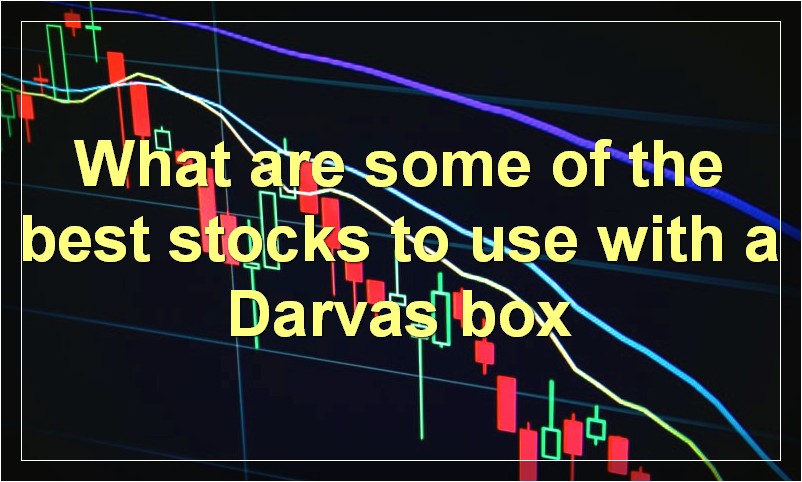If you’re looking for a way to improve your investment strategies, you should consider using a Darvas Box. This system can help you identify profitable opportunities and make better-informed decisions.
What is a Darvas box
A Darvas box is a technical analysis tool that was developed by trader Nicolas Darvas in the 1950s. It is used to identify potential buy and sell points for a stock based on price movements.
The Darvas box theory is based on the idea that a stock’s price will tend to move in waves. The tool is designed to help identify these waves so that traders can make better informed decisions about when to buy and sell.
The Darvas box is created by drawing a horizontal line at the highest high of the recent past, and then drawing a second horizontal line at the lowest low of the recent past. The resulting box is then used to identify possible buy and sell points.
Some traders use the Darvas box tool in conjunction with other technical indicators, while others find it to be a useful standalone tool. No matter how it is used, the Darvas box can be a helpful addition to any trader’s toolkit.
How is a Darvas box created

A Darvas box is created by drawing a line upwards from the lowest low of the recent past, and then drawing a horizontal line at the highest high of that same time period.
What are the benefits of using a Darvas box
The Darvas box is a simple but effective tool that can help traders identify potential buy and sell points in a stock’s price action. The key benefit of using a Darvas box is that it can help isolate trends from market noise, making it easier for traders to spot potential trading opportunities. Additionally, the Darvas box can also be used as a trailing stop-loss tool, which can help lock in profits on winning trades while minimizing losses on losing trades.
What are the drawbacks of using a Darvas box
There are a few potential drawbacks to using a Darvas box when trading stocks. First, it is possible to miss some good trade opportunities if the stock price only briefly touches the upper or lower boundary of the box before moving back in the other direction. Second, a stock may remain in a Darvas box for an extended period of time without giving traders a clear signal to buy or sell, which can be frustrating. Finally, because the Darvas box technique relies on past price action to identify potential trade setups, it is not always accurate in predicting future price movements.
How does a Darvas box help traders find profitable stocks
A Darvas box is a technical analysis tool that traders use to find stocks that are in an uptrend. The Darvas box is based on the work of Nicolas Darvas, who was a successful stock trader in the 1950s. Darvas developed a system for finding stocks that were poised to make big moves. He would buy these stocks when they broke out of a narrow range, or “box.”
The Darvas box is created by drawing two horizontal lines on a stock chart. The upper line represents the highest price that the stock has traded at in the recent past. The lower line represents the lowest price that the stock has traded at in the recent past. These lines create a box around the recent trading range of the stock.
When a stock breaks out of its Darvas box to the upside, it is considered to be bullish and traders will look to buy the stock. When a stock breaks out of its Darvas box to the downside, it is considered to be bearish and traders will look to sell the stock.
The Darvas box is a helpful tool for traders because it can help them identify stocks that are in an uptrend and are likely to continue moving higher. It can also help traders avoid stocks that are in a downtrend and are likely to continue moving lower.
What are some of the best stocks to use with a Darvas box

Some of the best stocks to use with a Darvas box are those that have a strong history of consistent growth. While there are no guarantees in the stock market, these stocks have proven themselves to be reliable performers over time. Here are a few examples:
-Apple Inc. (AAPL)
-Google Inc. (GOOGL)
-Amazon.com, Inc. (AMZN)
-Facebook, Inc. (FB)
These are just a few examples, but there are many other great stocks out there that would work well with a Darvas box strategy. The key is to find companies with a strong track record of growth and to carefully monitor their share prices. When done correctly, this strategy can lead to big profits!
How can I improve my results with a Darvas box
There are numerous factors that can affect the results of using a Darvas box. Perhaps the most important factor is the volatility of the markets. If the markets are highly volatile, it can be difficult to generate profits using a Darvas box. Another important factor is the size of the box. A smaller box will be more difficult to trade profitably than a larger box. Finally, the trader’s skill and experience will play a role in the success or failure of using a Darvas box.
With that said, there are several ways that a trader can improve their results when using a Darvas box. One way is to use multiple boxes. This will allow the trader to capture more profits as the markets move up and down. Another way to improve results is to use trailing stops. This will help to protect profits and limit losses. Finally, the trader should have a well-defined exit strategy before entering into any trade. By following these tips, the trader can improve their chances for success when using a Darvas box.
What are some common mistakes people make with Darvas boxes
There are a few common mistakes that people make when using Darvas boxes. One mistake is not waiting for the box to be hit before entering a trade. Another mistake is not having a proper stop loss in place. Sometimes people will also enter into a trade too early, before the box has been fully formed.
How can I avoid making mistakes withDarvas boxes
There is no surefire way to avoid making mistakes when using Darvas boxes, but there are a few things you can do to minimize the chances of error. First, be sure to carefully backtest your trading strategy before implementing it in live markets. This will help you identify any potential flaws in your approach and give you a chance to fix them before they cost you money. Second, keep a close eye on the market conditions surrounding your Darvas boxes. If the market starts to behave erratically, it may be time to take your profits and exit the trade. Finally, don’t be afraid to make adjustments to your Darvas boxes as needed. If a stock starts to move outside of your initial parameters, don’t be afraid to adjust your target price or stop loss accordingly. By following these simple tips, you can help ensure that you’ll be successful in your use of Darvas boxes.
What are some alternative methods to using a Darvas box
Some alternative methods to using a Darvas box are to use candlestick charts, Fibonacci retracements, or support and resistance levels. Candlestick charts show the open, high, low, and close prices for a security, as well as the trading volume. Fibonacci retracements are horizontal lines that indicate where a security’s price may retrace after an advance or decline. Support and resistance levels are price levels where a security’s price has difficulty breaching through.

